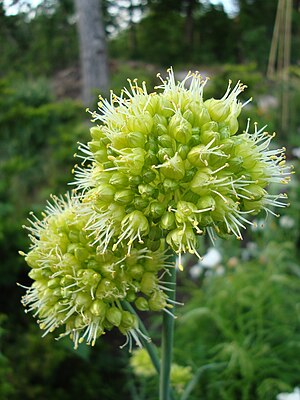Hot yellow leek
| Hot yellow leek | ||||||||||||
|---|---|---|---|---|---|---|---|---|---|---|---|---|

Yellow leek (Allium obliquum) |
||||||||||||
| Systematics | ||||||||||||
|
||||||||||||
| Scientific name | ||||||||||||
| Allium obliquum | ||||||||||||
| L. |
The Sharp Yellow Also ( Allium obliquum ) is a plant from the genus allium ( Allium ) in the subfamily of the leek plants (Allioideae). The plant is a Eurasian leek species , the range of which extends from Romania through Central Asia to Siberia . It is common as an ornamental plant , but like garlic it is also used in the kitchen and as a medicinal plant.
description
The hot yellow leek is a perennial herbaceous plant that reaches heights of 60 to 100 cm. The egg-shaped onions are up to 3 cm long and about 2 cm thick. The 4–10 simple, parallel-veined, gray-green leaves are flat and narrowly lanceolate, about 35 cm long and 0.5–2 cm wide. They enclose the lower half of the stem. Flowering time is in June and July. The golden inflorescences are hemispherical to spherical, about 4 cm wide with many pale yellow to greenish yellow, densely packed, cup-shaped flowers and a short bract . The pen stand out from the flower. The three pistils have become a top permanent ovary united and form a capsule fruit .
The number of chromosomes is 2n = 16.
Occurrence
The spicy yellow leek occurs from Romania through the Ukraine , Russia , Kazakhstan , Kyrgyzstan and Xinjiang in the extreme northwest of the People's Republic of China to Mongolia and Siberia . It grows there on meadows, wooded mountain slopes and in sparse forests. The plant prefers moderately dry, lime- and base-rich , well-drained soils in warm locations.
use
The hot yellow leek is suitable in the garden for steppe plantings in sunny, warm places with drained soil . Since the plant is fairly tolerant of different types of soil and soil moisture , has a subtle flower color and is also edible, it can also be used in rock gardens , near-natural perennial plantations and cottage gardens , as a companion perennial in rose beds or as a useful plant in vegetable and herb beds . The plant is considered hardy to −18 ° C ( zone 7 ).
The plant is used in parts of Siberia in the kitchen like garlic and is also considered a medicinal plant .
Systematics
The first publication of Allium obliquum carried out in 1753 by Carl Linnaeus in Species Plantarum . P. 296. The species-specific part of the name obliquum means "oblique, crooked, twisted" and refers here to the twisted leaves , which is also indicated by the common English name twisted-leaf garlic . The species becomes the subgenus Polyprason Radić and within it the section Oreiprason F.Herm. counted. According to recent DNA analyzes, the two yellow-flowered species, Allium obliquum and Allium petraeum, clearly belong to the species group of Allium saxatile .
literature
- Leo Jelitto, Wilhelm Schacht , Hans Simon: The outdoor ornamental perennials, manual and lexicon of garden perennials. Volume 1: A to H. 5th, completely revised edition, Eugen Ulmer Verlag, Stuttgart Hohenheim 2002, ISBN 3-8001-3265-6 .
Individual evidence
- ↑ a b Flora of China v 24 p 187 高 葶 韭 gao ting jiu Allium obliquum
- ↑ a b c A. P. Seregin, B. Anačkov, Nikolai Friesen: Molecular and morphological Revision of the Allium saxatile Group (Amaryllidaceae): geographical Isolation as the driving force of underestimated speciation. In: Botan. Jour. Linn. Soc. , Volume 178, 2015, pp. 67–101 (PDF file)
- ^ Piet Oudolf, Henk Gerritsen: Dream Plants for the Natural Garden. Frances Lincoln, London 2011, ISBN 978-0-7112-3462-8 , p. 69.
- ^ The Royal Horticultural Society: Perennials, The Great Encyclopedia. Dorling Kindersley Verlag, Munich 2015, ISBN 978-3-8310-2752-1 , p. 49.
- ^ Leo Jelitto, Wilhelm Schacht , Hans Simon: Die Freiland-Schmuckstauden, manual and lexicon of garden perennials. Volume 1: A to H. 5th, completely revised edition, Verlag Eugen Ulmer, Stuttgart Hohenheim 2002, ISBN 3-8001-3265-6 , p. 47.
- ↑ Allium obliquum - L. at Plants For A Future: (pfaf.org)
- ↑ Linnaeus, Carl von. 1753. Species Plantarum 1: 296.
- ^ Kew World Checklist of Selected Plant Families
- ↑ Nikolai Friesen, Reinhard M. Fritsch, Frank R. Blattner: Phylogeny and new intrageneric classification of Allium (Alliaceae) based on nuclear rDNA ITS sequences. In: JT Columbus, EA Friar, CW Hamilton, JM Porter, LM Prince, MG Simpson (eds.): Monocots: Comparative Biology and Evolution I. In: Aliso. Volume 22, 2006, pp. 372–395, (PDF file)
- ↑ Qin-Qin Li, Song-Dong Zhou, Xing-Jin He, Yan Yu, Yu-Cheng Zhang, Xian-Qin Wei: Phylogeny and biogeography of Allium (Amaryllidaceae: Allieae) based on nuclear ribosomal internal transcribed spacer and chloroplast rps16 sequences , focusing on the inclusion of species endemic to China. In: Annals of Botany , Volume 106, Issue 5, 2010, pp. 709-733. doi : 10.1093 / aob / mcq177 , PMC 2958792 (free full text).
Web links
- Allium obliquum - L. at Plants For A Future: (pfaf.org)
- Allium obliquum - L. at Global Biodiversity Information Facility (GBIF): (gbif.org)
- Allium obliquum L. at Tropicos: (tropicos.org)
- Ail à Feuilles Obliques at Encyclopedia of Life: (eol.org)
- Allium obliquum L. - Twisted leaf garlic at Agricultural Ecological Atlas of Russia and Neighboring Countries: (agroatlas.ru)

